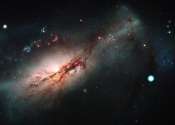Dutch astronomers prove last piece of gas feedback-feeding loop of black hole
Three astronomers from the Netherlands have proven that gas that was previously heated near a supermassive black hole flowed to the outskirts of the galaxy and cooled down, moving back towards the black hole. While there ...









